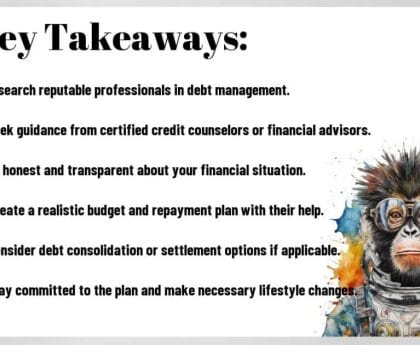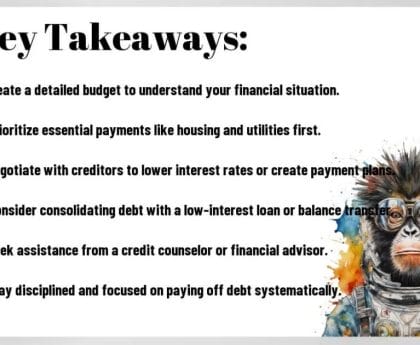Are you currently struggling with mounting debts and the consequences of excessive borrowing? You’re not alone. Many individuals find themselves trapped in a cycle of financial insecurity due to high levels of debt and reckless borrowing. However, it is possible to break free from this damaging cycle and regain control of your financial future. In this informative blog post, we will explore practical strategies and steps to help you overcome your financial problems and pave the way to a more stable and secure financial situation. From creating a budgeting plan to exploring debt repayment options, we will provide valuable insights and tips to assist you in achieving financial freedom.
Key Takeaways:
- Assess Your Situation: It’s crucial to take an honest look at your financial situation and assess the root cause of your high levels of debt and excessive borrowing. Understand your spending habits, budget, and debts in order to effectively address the problem.
- Create a Plan: Developing a clear and realistic plan to pay off your debts and reduce borrowing is essential. This may involve creating a budget, identifying areas where you can cut expenses, and exploring debt consolidation options.
- Seek Professional Help: If you’re feeling overwhelmed by your financial situation, don’t be afraid to seek help from a financial advisor or credit counselor. They can provide valuable guidance and support to help you break free from financial problems caused by high levels of debt and excessive borrowing.
Assessing Your Financial Situation
Some of us may feel overwhelmed by our financial situation, especially when high levels of debt and excessive borrowing are involved. However, before we can take steps to break free from these problems, we must first assess our current financial state. This will provide us with a clear understanding of how much debt we have, our income, and our debt-to-income ratio. By doing so, we can develop a plan to tackle the issues head-on and work towards financial freedom.
How to Calculate Your Total Debt
With the vast array of debt sources available, it can be challenging to determine the exact amount of debt we hold. Start by gathering all your financial statements, such as credit card bills, loan balances, and mortgage statements. Add up the outstanding balances to get your total debt. Once you have this figure, you can then begin to categorize the debt into consumer debt, such as credit cards and personal loans, and mortgage or car loan debt.
Understanding Your Debt-to-Income Ratio
On top of calculating your total debt, it’s crucial to understand your debt-to-income ratio. This is the percentage of your monthly income that goes towards paying off debt. To calculate this, add up all your monthly debt payments and divide them by your total monthly income. A high debt-to-income ratio indicates that a large portion of your income goes towards servicing debt, which can be detrimental to your financial health. Ideally, this ratio should be below 36%, with anything above raising red flags about your ability to take on additional debt and manage your current financial obligations.
DebttoIncome ratio is a key metric that lenders use to assess a borrower’s ability to repay debt. It is also an important indicator of financial stability and the level of risk associated with taking on more debt. By understanding and monitoring your debt-to-income ratio, you can make informed decisions about managing your debt and financial commitments.
Strategies to Curb Spending and Reduce Debt
Not being able to control spending and accumulating debt can be a major source of financial stress and anxiety. However, there are effective strategies you can implement to curb your spending habits and reduce your debt levels.
Creating a Sustainable Budget
One of the most important steps in reducing debt and curbing spending is to create a sustainable budget. This involves analyzing your income and expenses to determine how much you can realistically afford to spend each month. Additionally, allocating a portion of your income to repay debt also needs to be a priority. By sticking to a budget and setting limits for your spending, you can ensure that you are not living beyond your means and are actively working towards reducing your debt.
Essential Tips for Cutting Unnecessary Expenses
On top of creating a sustainable budget, there are essential tips that can help you cut unnecessary expenses and save money. Avoid impulse purchases by creating a shopping list and sticking to it when you go grocery shopping or run errands. Consider downgrading your subscription services, such as cable and streaming platforms, and only keeping the ones you regularly use. Additionally, consider finding alternative, cheaper ways to entertain and socialize, such as hosting a potluck dinner instead of dining out. These small changes can add up to significant savings over time. Thou by cutting these unnecessary expenses, you will have more disposable income to put towards repaying your debt.
Essential tips for cutting unnecessary expenses can be life-changing for individuals struggling with debt. By actively making an effort to cut back on non-essential spending, you can alleviate the financial burden and work towards achieving a debt-free future. These tips can help individuals to take control of their finances and make more mindful decisions when it comes to spending.
Debt Repayment Plans and Methods
Unlike the common misconception that there is only one way to repay debts, there are actually various plans and methods available for individuals struggling with high levels of debt and excessive borrowing. Understanding these options can help you make informed decisions and create a plan that works best for your financial situation.
The Snowball vs. Avalanche Methods
Snowball method involves paying off the smallest debts first, regardless of interest rates, to build momentum and motivation. On the other hand, the avalanche method focuses on tackling debts with the highest interest rates first to minimize the overall interest paid. Both methods have their advantages and disadvantages, and the most suitable approach will depend on your financial goals and circumstances.
Consolidation and Refinancing Options
One common way to simplify debt repayment is through consolidation and refinancing. This involves combining multiple debts into a single loan with a lower interest rate, making it easier to manage and potentially saving money on interest payments. For instance, consolidating credit card debt into a personal loan or refinancing a mortgage can provide relief from high interest rates and fluctuating monthly payments.
For individuals with multiple loans and credit card debt, consolidating and refinancing can streamline their repayment process, reduce the total interest paid, and offer a clear path towards becoming debt-free. However, it is important to carefully consider the terms and conditions of the new loan or refinance to ensure that it aligns with your long-term financial goals and doesn’t lead to further financial strain.
Building a Financial Safety Net
After breaking free from financial problems caused by high levels of debt and excessive borrowing, it’s essential to focus on building a financial safety net to prevent falling back into the same predicament. The safety net will provide a buffer against unexpected expenses and help maintain stability in your financial life.
The Importance of an Emergency Fund
One of the key components of a financial safety net is an emergency fund. This fund should ideally cover 3-6 months of living expenses and can be accessed in the event of unexpected financial hardships, such as job loss, medical emergencies, or major car repairs. By having a substantial emergency fund, you can avoid going into debt to cover these unexpected expenses, protect your financial stability, and secure your peace of mind.
When and How to Seek Professional Financial Advice
Fund seeking professional financial advice is important when dealing with complex financial situations or seeking a professional opinion on how to effectively manage and grow your wealth. It is crucial to seek the advice of a certified financial planner or advisor who can provide objective guidance and help you develop a customized financial plan based on your specific financial goals and circumstances.
Seeking professional financial advice can prevent making costly mistakes and empower you to make well-informed financial decisions. A qualified professional can help you optimize your financial strategy, minimize risks, and maximize opportunities for financial growth.
Conclusion: How to Break Free from Financial Problems Caused by High Levels of Debt and Excessive Borrowing
Now is the time to take charge of your financial health and break free from the cycle of debt and excessive borrowing. By creating a budget, living within your means, and prioritizing debt repayment, you can take control of your financial future. Additionally, seeking professional help from a financial advisor or credit counselor can provide guidance and support as you work to overcome your financial challenges. Remember, it is possible to break free from the burden of debt and achieve a more stable and secure financial future.
FAQ
Q: What are the common causes of high levels of debt and excessive borrowing?
A: High levels of debt and excessive borrowing can be caused by various factors such as overspending, unexpected financial emergencies, lack of budgeting and financial planning, and reliance on credit to cover daily expenses. Additionally, high interest rates and fees on loans and credit cards can exacerbate the problem.
Q: How can I break free from financial problems caused by high levels of debt and excessive borrowing?
A: To break free from financial problems caused by high levels of debt and excessive borrowing, it’s important to create a realistic and manageable budget, prioritize debt repayment, and avoid taking on new debt. Consider seeking professional financial advice and exploring debt consolidation or settlement options to streamline payments and reduce interest rates. It’s also crucial to change spending habits and focus on building an emergency fund for future financial stability.
Q: What are the long-term effects of high levels of debt and excessive borrowing?
A: High levels of debt and excessive borrowing can have long-term effects on an individual’s financial well-being, including damage to credit scores, limited access to future credit or loans, stress and mental health issues, strained relationships, and potential legal repercussions such as bankruptcy. It can also hinder the ability to save for retirement or major life events and limit overall financial freedom and opportunities. Taking proactive steps to address and eliminate debt is crucial in avoiding these long-term consequences.






